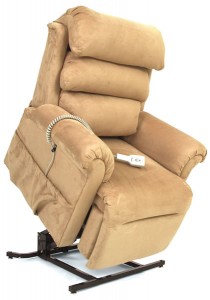Understanding Lift Chair Measurements
Published by Steve Hedberg on October 13, 2008 Under lift chairs
 Even though people of any age can find themselves having difficulty standing independently, it is far more common among seniors. Many times diseases, such as arthritis, can make it very hard and painful to stand. Cognitive disorders that affect a persons balance can also add to this difficulty. Those that are unable to stand safely or without assistance often turn to lift chairs to help.
Even though people of any age can find themselves having difficulty standing independently, it is far more common among seniors. Many times diseases, such as arthritis, can make it very hard and painful to stand. Cognitive disorders that affect a persons balance can also add to this difficulty. Those that are unable to stand safely or without assistance often turn to lift chairs to help.
A lift chair is in many ways very similar to the traditional recliner that adorns so many peoples living rooms. However, lift chairs also make it possible to stand without any help from others. This is because the chair actually slowly raises its occupant safely to a standing position. They use a strong lifting mechanism, which is controlled electronically and located in the base of the chair.
As the chair rises, it tilts at a slight angle that safely deposits the occupant on their feet. When choosing a lift chair, one of the most important measurements is the chairs height rating. Choosing a chair that is made for a taller person, could result in serious injury. The height rating is determined by how high the chair rises and if it rises too high for your height, it could leave you off balance.
Another important measurement is the chairs weight capacity. Most chairs are able to support more than three-hundred pounds and some can support over seven-hundred pounds. Adhering to the weight capacity is very important and you always want to have a little wiggle room. It is usually recommended to have at least 20 extra pounds of weight capacity for every hundred pounds of body weight. If you anticipate that you might gain weight, you should also take this into consideration.
While the height and weight ratings are the most important, there are also several other measurements that should be considered when choosing a lift chair. The seat width and seat depth are two measurements that can directly affect your comfort. It is a good idea to measure your existing chair, so that you have some basis for comparison.
Using a tape measure or ruler, measure the distance between the armrests of your existing recliner. Make sure to measure with the ruler touching the seat of the chair. This is called the seat width.
Next use the ruler to measure the distance from the front of the seat to the edge of the backrest, again ensuring that the ruler is touching the seat when you take the measurement. This is the seat depth.
Once you have these measurements, compare them to the posted measurements of the lift chair. This way you will be able to judge the size of the lift chair, without having to sit in it.
While the height rating, weight capacity, seat depth, and seat width are all very important. Most lift chairs also have other measurements and dimensions posted. You can use your existing recliner’s measurements to serve as a base for understanding a lift chair.
No Comments |